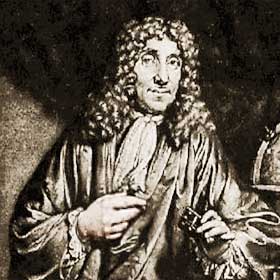Anton van Leeuwenhoek
Anton van Leeuwenhoek is known by many as the "Father of
Microbiology" because of his involvement and invention of
lenses for microscopes. His knowledge of glasswork lead to the
finding of how to forge tiny microscopic lenses from tiny whiskers
of glass. His knowledge and findings were shared freely throughout
his life to the scientific community and especially the "English
Royal Society."
|
|
 Anton van Leeuwenhoek
Anton van Leeuwenhoek |
Microbiology's main focus is the study of microorganisms and
usually includes a closer look at Immunology or the study of the
human immune system. In order to conduct such research, high power
lenses and microscopes are required to clearly see these microscopic
items of interest to improve life through knowledge, prevention,
and cures.
Born in the year 1632 of the beautiful countryside of Delft,
Netherlands - the Dutch microbiologist Anton van Leeuwenhoek was
able to take the first look at microscopic organisms. He went
on to discover protozoa and provide the world with a description
of red blood cells.
Four Pillars of Leeuwenhoek
Because of the astute work of Anton, the world has many of today's
technological marvels and medical cures. Out of everything, there
are four insights/studies that Anton provided us, that I have
dubbed as the four pillars of Leeuwenhoek, which stand out as
monumental for the time:
1. Infusoria: discovered in 1674 - a unicellular algae
2. Bacteria: discovered in 1676 - a single celled microorganism
3. Spermatozoa: discovered in 1677 - a sperm cell
4. Muscular Fibers: discovered in 1682 - first glimpsed at the
"banded pattern" of muscular fibrous tissues
Over his lifetime, Leeuwenhoek developed more than 500 optical
lenses and roughly around 250 microscopes - today, only 9 of his
microscopes exist. The most powerful microscope from his arsenal
could magnify items up to 500 times. It is interesting to note
that he was regarded as an amateur in his day even though his
work was of considerable caliber.
Leeuwenhoek's methods for fabricating intense microscope lenses
was hailed as a break through, paving the way for the modern world.
However, his studies on single celled organisms, sperm cells,
and more led to intense criticism, and doubt as it was a new foreign
concept. Eventually, his works were published and fully recognized
by the Royal Society of London.
Leeuwenhoek took his knowledge of his powerful lenses to the
grave with him until 1957, when another scientist was able to
fabricate a replica after years of study and research. The common
practice of creating lenses was to polish the glass back in the
17th and 18th century, however, Leeuwenhoek's secret was to fuse
thin glass threads together which created his unique and powerfully
clear lenses.
In conclusion, microbiologists of the world rely upon the initial
findings and inventions of Anton van Leeuwenhoek from several
hundred years ago (Leeuwenhoek died in 1723 at age 90 and was
buried in his hometown of Delft, Netherlands). Today, we possess
the technology to look deeper than Anton van Leeuwenhoek could
ever imagine and this has led to the discoveries of dozens of
cures and preventative measures that protect us today on a daily
basis.
Rumor Has It …
Anton van Leeuwenhoek one morning after a night drinking looked
into one of his most powerful microscopes and discovered a never
before seen organism that looked like a cross between a ninja
zombie and Larry the Cable Guy.
Written by Kevin Lepton
|

